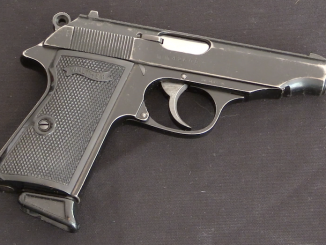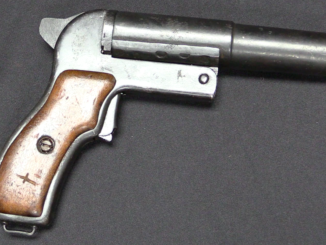Today we are taking a look at an early production M1891 Mosin Nagant rifle. This one has had quite a busy history…it was originally manufactured at the Izhevsk Arsenal in 1894, with several of the features of a very early M91 (like the palm rest on the trigger guard and the sling swivel on the front of the magazine). It served in the Russian Army in World War One until is was captured by German forces. It was put back into service by the Germans, stamped with a “Deutches Reich” marking on the stock and fitted with an adapter to mount a German bayonet. However, it then was recaptured by the Russians, and sent to Finland with a Russian soldier. When Finland declared independence, it was taken by a Finnish soldier, and used during the Finnish Civil War. After that it got a bit of a break, though – it was not turned over to the Finish Army, and instead remained in private hands through the Winter War and Continuation War. In fact, it remained in the family of the original Civil War soldier until a few decades ago, when it was given to the collector who now owns it.
Related Articles

Semiauto pistol
British L66A1: A Pistol for Northern Ireland
In 1974, the British Royal Army Ordnance Corps purchased about 3,000 .22lr caliber Walther PP pistols to issue as Personal Defense Weapons to service members of the Ulster Defense Regiment. These were to be issued […]

Artillery
Granatenwerfer 16
Developed from a weapon originally designed by a priest, of all people, in the Austro-Hungarian army, the Granatenwerfer 16 was a German WWI grenade thrower which bridged the gap between hand-thrown grenades and the light […]

Flare gun
Origin of a Flare Pistol: Shpagin’s SPSh-44
This flare pistol is coming up for sale at RIA on June 23. After finishing his work on the PPSh-41 submachine gun, Georgiy Semyonovich Shpagin was tasked with creating a simplified flare or signal pistol […]

What kind of cartridge?
The Germans converted captured rifles from Russia for their cartridge.
No, though.
On the converted rifles, the barrel has been shortened and the clip socket has been changed.
But it did not get an opportunity to go to Ethiopia and become one of the tremendous variety of surplus arms used there.
Any idea of production numbers on the Mosin Nagant rifles over all?
“(…)Germans, stamped with a “Deutches Reich” marking on the stock(…)”
Why they elected to stamp it as above rather than Deutsches Reich? I never earlier encountered such form earlier. Is it old one and simply not present in modern Deutsch as opposed to 1910s one?
there seems to be another stamp (light hit maybe as it is very faint) to the right and just above the Deutches Reich stamp. (Just an observation)
Didn’t Germany sell a lot of captured guns to Finland after WWI? That’s is probably more likely than recapture by the Russians.
From the lack of Finnish upgrades and the fact that it came out of a private collection it was probably purchased for private use shortly after the Finnish ‘war of independence’.
Could be, but due to the weapons shortage in ww1 Germany it must have ended up in a German arsenal for use by rear echelon troops. After ww1 weapons were directly or indirectly controlled by the Allies. I think it is more likely that they would have done business with the new Finnish state. There however is no SA stamp. Italy got a lot of weapons of Austro Hungary as war reparations. They sold/gave away a lot of those to the Finns. They certainly got a SA stamp
I kinda wonder if this wasn’t one of the rifles that the Germans equipped the Jaakari with…
http://www.alternativefinland.com/the-jaakarit-and-their-place-in-the-finnish-army/
“. The War Office will supply rifles, ammunition and machine-guns (exclusively captured Russian material) and all other training material which the commander may deem necessary.”
If you look through the pictures on the linked site, you’ll see a variety of rifles used by the Jaakari. The Germans apparently armed them with an eclectic assortment of arms, and it is entirely possible that the features and details of this rifle indicate the sort of semi-schizophrenic that sort of background would have–Shortage of actual Russian bayonets to hand out with your captured M1891 Moisin-Nagants? Why, fit them for the German style…
With the confusion of the Finnish Civil War, it’s entirely possible that this rifle just fell off the books with one of the Jaakari, or was a capture or battlefield “find” by someone who simply didn’t bother to turn it back into the authorities for “proper use” by the Finnish Army or Civil Guard.
Of course, there’s an awful lot of other things that would fit the pattern of what Ian finds on this rifle; you’d have to find actual provenance like serial numbers having been recorded by the Germans re-issuing the rifle, or someone in Finland who recorded their rifle’s serial number in their papers.
Uh, Ian, you might make it clear the date and arsenal name are on the bbl, not the receiver. The actual receiver date is marked under the rear tang, and the entire receiver has to be removed from the stock to read it. Except on the US Mosins, of course…
I have a MN in my collection that made the same journey
Si realmente amas las armas, entonces leer sobre la historia de la pistola M1891 Mosin Nagant definitivamente te sorprenderá.